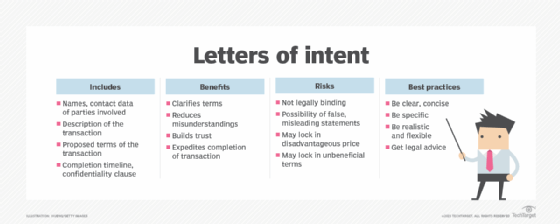letter of intent (LOI)
What is a letter of intent (LOI)?
A letter of intent (LOI) is a written, nonbinding document that outlines an agreement in principle between two or more parties before a legal agreement is finalized. It is often used in business transactions, such as mergers and acquisitions, joint ventures and real estate leases.
What is included in a letter of intent?
A letter of intent typically includes the following information:
- Names and contact information of parties involved.
- A description of the transaction.
- The proposed terms of the transaction.
- A timeline for the completion of the transaction.
- A confidentiality clause.
Why is a letter of intent important?
A letter of intent can be a vital instrument for businesses and other organizations.
First, it helps clarify the terms of a proposed transaction, ensuring all parties involved have a clear understanding of what is being agreed upon. This clarity reduces the risk of misunderstandings that could potentially disrupt the transaction.
A letter of intent can build trust between the parties involved by establishing a mutual understanding and a shared vision for the transaction. They can also expedite the completion of a transaction by outlining the terms and expectations from the onset, thus streamlining the negotiation and execution process.
For instance, consider two companies planning to merge. They would benefit from entering into a letter of intent that outlines the terms of the merger, including aspects such as the merger price, the exchange ratio and the anticipated date of the merger.
Such a strategic move ensures that both companies have aligned expectations, thus mitigating the chance of unexpected hitches when it's time to finalize the merger agreement.
What are the risks of using a letter of intent?
There are a few risks associated with using a letter of intent. First, it is important to remember that a letter of intent is not a legally binding document. This means that the parties involved are not legally obligated to complete the transaction, even if they have signed a letter of intent. However, if one party breaches it, the other party may be able to sue for damages.
It is also important to be aware that a letter of intent can be used to make false or misleading statements. For example, a company may claim it has secured financing for a merger when it has not. This could give the other party the false impression that the merger is a sure thing when, in fact, it is not.
Finally, a letter of intent can be used to lock in a price or other terms that may not be in the best interests of one or more parties. For example, a company may agree to a price for a merger that is below market value. This could result in the company losing money on the merger.

How to write a letter of intent
There is no one-size-fits-all approach to writing a letter of intent. However, there are some general tips that can be helpful:
- Be clear and concise. The letter of intent should be easy to understand and should not contain any legal jargon.
- Be specific. The letter of intent should include as much detail as possible about the transaction, such as the price, the exchange ratio and the date of the transaction.
- Be realistic. The letter of intent should be based on realistic expectations and should not contain any unrealistic promises.
- Be flexible. The letter of intent should be flexible enough to allow for changes if necessary.
- Get legal advice. It is always a good idea to get legal advice before signing a letter of intent.
What happens after a letter of intent is signed?
Once a letter of intent is signed, the parties involved typically begin negotiating the terms of the final agreement. If the parties are unable to reach an agreement, it may be terminated.
When used appropriately, a letter of intent is a useful tool for businesses and other organizations that are considering entering into a transaction. It can help to clarify the terms of the transaction, reduce the risk of misunderstandings and build trust between the parties involved.
Partnering in the IT industry can be tricky. Learn about new approaches, such as co-innovation and generative partnering.
